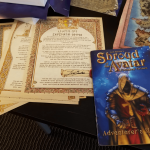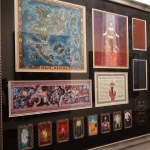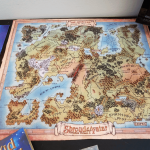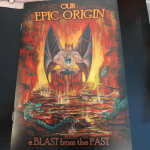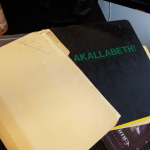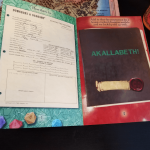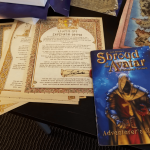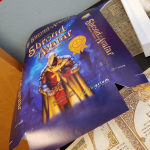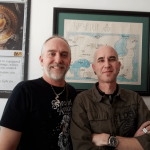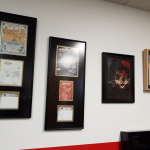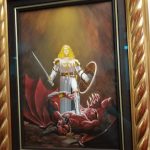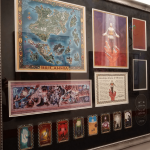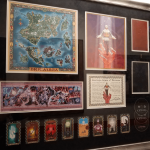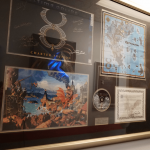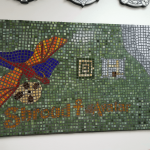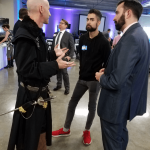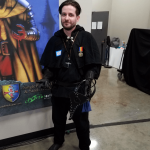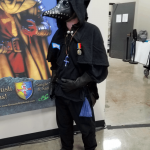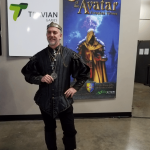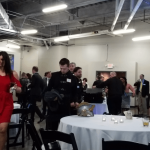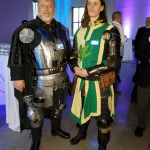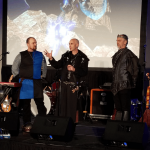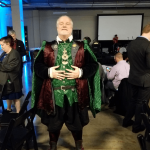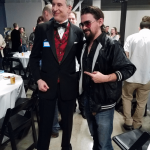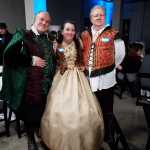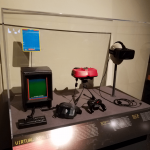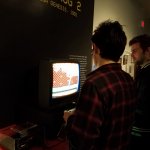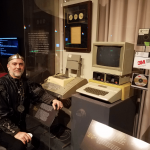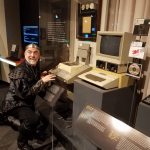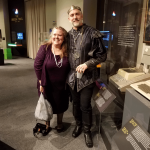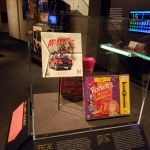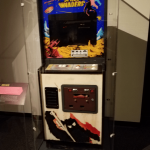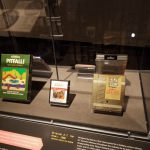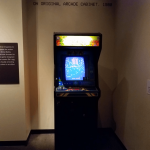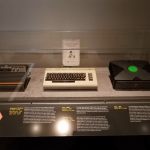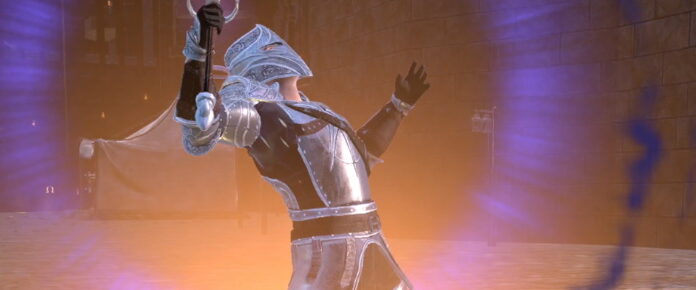The day is finally arriving: Shroud of the Avatar is formally launching next week. It’s been a long journey. The path to this new old-school MMO started back on Kickstarter on March 8th, 2013. Now, five years almost to the day, SOTA is emerging. On March 27th, release #52 will be the official launch of episode 1. And fans didn’t have to wait until the end of the month to celebrate; Portalarium hosted a launch party this past week in Austin, Texas.
Besides hanging out with devs and fans at the shindig, I visited the studio’s offices for a tour and interview with Richard Garriott and Starr Long. There, I got to see memorabilia from the very beginnings of Garriott’s game-making career as well as a sneak peek of the events that will occur at SOTA’s launch. After that, it was celebration time at the awesome From Pong to Pokemon exhibit at the The Bullock Texas State History Museum (which happened to have a display of some of Garriott’s early gaming goodies!)
Before the party got underway, I went to the offices (not the original small cabin by the lake, sadly) to have a chat with Garriott and Long. We talked about how far the game had come, the benefits of the open development (instant feedback!) as well as the negatives (why isn’t the game done when I can play it?), the team’s pride in never missing an on-time launch of any of the 51 releases, communication, and the upcoming marketing push that will happen right after launch. I also queried them about housing, finances, in-game spreadable diseases, the possibility of mobile companion apps, and combat. I got to tour the results of the in-game launch event as well as tour the office itself. (I also learned a couple of fun facts: Ultima IV was forged from the desire to make a game about virtue after getting fan mail from Ultima II and learning that people were killing off all the NPCs and Lord British; and Garriott’s favorite cover is Ultima VI, because of how it relates to the game.)
[Editor’s note: This meeting took place before the account migration situation, about which we are still querying the developers.] A look at history
A look at history
During the interview and tour, Garriott admitted that he was a fellow packrat, and I was able to see a chunk of his personal and professional gaming history. I saw the actual teletype that his first-ever game called D&D 1 was programmed on (you can actually play this teletype game inside SOTA!), a tote full of all the floppy disks of game updates (when floppies were a thing), and thumbed through the notes and sheets of the first-ever Dungeons & Dragons campaign he ran along with his first D&D character sheet. (Fun fact: He has actually run fans through that first campaign when they visit the offices. I sure wish we had more time before the party!) I also got to see original artwork of the entire span of Garriott and the company’s game-making careers, including one cover created by his then art-director mother. Many fans will soon be enjoying replicas of some of these items thanks to the collectors boxes, which I was able to preview.
Speaking of those collectors boxes, early backers who got the limited editions collectors game boxes will get their items right after launch. However, those who missed out then who still want the items like the cloth SOTA map will have a chance to do so. Garriott said they are going to over-manufacture the boxes and offer a limited supply of regular editions (sans special land grant certificates, etc). A few thousand of these new regular editions will be available.
 An earth-shattering launch (mild spoiler alert!)
An earth-shattering launch (mild spoiler alert!)
Let’s start in the reason for the season: launch. Many players have correctly surmised that the massive meteor currently flying through the sky, showering the map with smaller meteors, is going to touch down on the launch date. What they may not realize is the scale of destruction that will entail. No, there won’t be a wipe or loss of land (although Garriott emphasized that players will be able to reset their current avatar to restart the story over or to create more characters). One entire section of map, however, will get decimated. The landscape will be forever altered, so if you’d like to see Quel as it is now, you’ve got only one week to do so! I know I need to.
I have to say, the new adventure zone taking its place is pretty awesome-looking. Now called Quel Shardfall, the land has a massive crater with the bulk of the meteor driven into the ground and smaller shards hanging in the air. More than just a cosmetic change, the meteor’s path also unearthed, as Garriott put it, “an ancient evil that had been buried and locked away here.” If you are ready for the challenge, there are some unique rewards waiting for players who explore this area.
We also toured The Lost Vale, a special map that appears for only one hour every 28 hours. It is a ghostly zone that basically retells the story of the cabalists — the prequel history 200 years before SOTA. I can’t wait to play through this on my own (but only after I finish the prequel book, Blade of the Avatar.)
Hurrah for housing
Housing isn’t just one of my all-time favorite features in a game; it’s one of the features that many folks interested in Shroud of the Avatar are keen on. Before we delved into questions, Garriott showed off the decorating system. I’ve known about the in-game phonographs and radios, and now I have learned about the in-game teletype machines. (I love the fact that players have designed and developed roleplay enhancing features!) During our demo, I also got to experience a special item that follows the exact positioning of the heavenly bodies so players can track things like the cabalists.
What I didn’t know at all was that gravity is actually a force when decorating. Garriott demonstrated that when you move any item that has items placed inside/on top of it, those items move as well! Man, that would have saved me many decorating headaches over the years. And the clocks in-game actually show real game time. “I think that we have created the most sophisticated and easiest to use decoration system that exists.” Garriott said. Additionally, he pointed out that although some items are purchased and placed as whole pieces, many items are created and crafted by players and then placed. Those decorative planters had to be planted with a seed to display a plant.
SOTA housing is a beautifully deep system. I had to agree when Garriott stated, “If you add that to all the crafting we do from raw materials to finished product, I personally find [the system] quite impressive.” That said, can average players fully experience it? There is worry that folks can’t participate unless they fork over tons of cash, or couldn’t find land even if they did. Is housing pay-to-win? Is all the land gone? We addressed these two big concerns. Garriott and Long’s answer in short: Yes, land is a limited resource, but there are opportunities for housing for all who want it.
 Addressing property as pay-to-win
Addressing property as pay-to-win
The P2W concern is not lost on Garriott and Long. Garriott said, “The concern of pay-to win, whether it’s the housing or power, I think is not just fair, it is a reasonable concern for anybody to have about every game that allows you to pay for anything going into it.” In regards to negating pay-to-win in SOTA, Garriott said, “I think we did it well.” Long expressed that he felt communication was a factor in the pay-to-win concern, adding:
“We’ve been very, very, very careful along the way to make sure that [for] anything that’s on the store there is the equivalent in the game — and always more. So for everything that is on the store, there are at least two of the same thing in the game that can be crafted or found from looting. I think the issue for us is on communication. I am firmly on the side that we are not pay-to-win in any way. And that people have decided perhaps that we are, and that is on us that we probably haven’t done a good enough job communicating all the ways that we’re not.”
![]() True, there isn’t enough land for every player in game to own it, but there are still ways to for those who want housing to obtain it. “Because it’s a single world, there is a limited amount of real estate. Real estate is a valuable commodity.” Garriott said. Then he emphasized:
True, there isn’t enough land for every player in game to own it, but there are still ways to for those who want housing to obtain it. “Because it’s a single world, there is a limited amount of real estate. Real estate is a valuable commodity.” Garriott said. Then he emphasized:
“We want to make sure that anybody who wants real estate and is actually going to take the time to maintain it, we want you to have property. What we don’t want is somebody to own property and then just kind of leave it fallow because now they’re burning space in the game that would actually be more fun for everybody if it was put to use.”
Can players acquire a house and property without paying Portalarium cash? Absolutely, both Garriott and Long vowed. Long pointed to players on the forums who have guides for what they did and how long it took to build theirs. According to these guides, it takes about a month of play time to acquire a home and property. And that housing — no matter how it is acquired — has value, so that players can also turn around and sell theirs in game in order to get another item they might want, such as a boat. Garriott and Long explained that the whole idea is to drive housing into the player economy, so players can supporting the needs of other player and the devs can step out of it as much as possible.
This philosophy is also manifested in renting. Folks who don’t want to worry about property ownership and maintaining it can still enjoy housing thanks to the new renting system. Long noted that some players rent out houses (or rooms in an inn) while others on the forums advertise that they are giving out free housing. This information is now communicated to players via a flier they find in their backpack when starting the game. Players can also find information on town bulletin boards. And with this system, even if players leave game and are evicted, all of their stuff is sent safely to their bank. Does renting work? Well, thanks to a connection made at the launch party, I might be running a vacant inn for another player until I can gather enough raw materials in game to build my own.
 Funding and finances
Funding and finances
With the game switching from Early Access to launch, that bring up the question about changes in funding and finances. Although all of the revenue used to come from the web site, most will move into the game. New players will still be able to buy the game and starter pack upgrades on the site, but most all of the economy will move into game – that’s according to Garriott. “The way that we are already starting to move the economy is to where most players will trade with other players for just gold in the game that is normally dropped,” he added. Most transactions in game will be gold, but players can also use the intermediary currency, COTO, for transactions. (Note: COTO does drop in the game as well and also has other functions, including being an ingredient in potions and such.)
As for finances, Garriott said that concurrency numbers over the last few months have been steadily increasing, even without real marketing. True, the studio does try to convert the free trial players to a paid account that isn’t limited. Other than that, however, word of mouth, some press coverage, and a tiny bit of test marketing is pretty much all that has happened. Garriott said they didn’t want to draw in the massive crowds before the game was finished, knowing that would turn many potential players off. However, once the game launches, there will be a massive marketing blitz. He said, “A sizable chunk of money will be spent to try to bring in new players.”
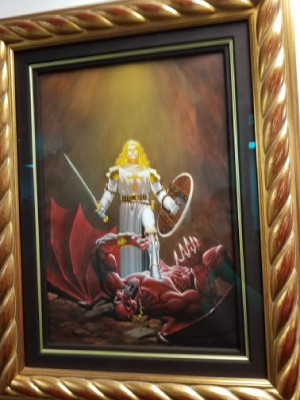 Other tidbits on disease, apps, and combat
Other tidbits on disease, apps, and combat
As time was winding down and the party was nearing, I slipped a few more questions in. Here are the answers to those:
Spreadable diseases were actually in game for a time, but some players had used them to grief others, so the system was removed. Garriott and Long did discuss that it could be re-implemented by perhaps tying to being PvP flagged only.
What about mobile companion apps? The community has made some already; one has the community calendars, avatar radio stations, maps, and more. Garriott stated, “Long term, do we want to see this become bigger and richer and deeper, and may even assign some of our own time to it? Absolutely, if we get to a state where we have the ability to add some of our own time and money to it.” Long added that the team has talked about a companion app that has something like managing the stock of your vendors. (Please, please, oh please yes!) “Anything that didn’t involve having to navigate the 3D space is a candidate for a great companion app,” Long said. This includes, managing tenants, updating message boards, and maybe making books.
Lastly, we talked about the seemingly divisive feelings about the game’s combat; some like it, and some really don’t. “I think much of the love/hate is from past players,” Long suggested. But is it still that way after the combat changes? Long explained that SOTA can now be played like a traditional MMO by dragging and dropping skills on the hotbars and using them. However, players can also specifically choose to play the dealt deck combat and have that added challenge and utilize those combos. This happens by unlocking a slot and loading it up with which skills you want to be shuffled in that slot. Each slot is unlocked independently, so players can always leave one locked that has a must-have skill, like healing.
Celebrate launch times, come on!
After the interview, it was time to hang out with other fans, chat about the game, eat some Texas bbq, chat with devs, and listen to a mini concert from Shooter Jennings (whose music appears in game). There was camaraderie and cosplay. Players were able to meet back up with other fans or put faces to names for the first time. Folks also got to check out the museum exhibit, Pong to Pokemen, which had two items from the Portalarium offices on display — an original teletype and Garriott’s own Apple II that he did his early programming on. You could even play a number of the games. It was a relaxed affair, even though everyone was excited about launch. 10/10 would do it again.

